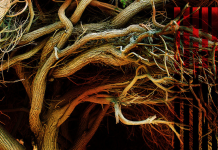 Green Hermeticism: Alchemy and Ecology, by Peter Lamborn Wilson, Christopher Bamford and Kevin Townley
Green Hermeticism: Alchemy and Ecology, by Peter Lamborn Wilson, Christopher Bamford and Kevin Townley
Lindisfarne Books, 9781584200499, anti-copyright 2007
In 2003 Peter Lamborn Wilson gave a lecture titled “The Sacred Theory of the Earth” at a conference held in New Paltz, New York. This talk inspired a series of lectures and the coining of a new term “Green Hermeticism.”
The lecture given at the first conference became the first chapter of the present work, “The Disciples at Sais: A Sacred Theory of Earth.” Here he discusses the work of Novalis (Friedrich von Hardenberg), an early Germanic Romantic poet and philosopher, and contextualises him in terms of defining a new spiritual ecology linked to alchemy and hermeticism.
In “One the All,” editor in chief of SteinerBooks and Lindisfarne Books, Christopher Bamford, discusses creation myths, though I found his overview of alchemy more enlightening. He writes:
“Hermetic science is…a discipline of mind and body. Rather than the objectification and control of the known by the knower, it seeks unification and identity- thereby transforming the knower and the known as perceived and experienced. The “object” is conceived of as a symbol. Everything observable is a symbol. Every symbol is observable”. But note that a symbol or phenomenon, though observable, is not “repeatable” in the sense that ordinary science depends on repeatability. Each observation or empirical confirmation is unique, single: an act of grace manifesting in the confluence of the right gesture at the right moment. Hermetic science strives for a known in the symbol through the act of knowing.”
In the title lecture and essay, “Green Hermeticism,” Wilson gives a lucid analysis of Hermetic history, noting “[s]syncretism values the fortuitous mistranslation just as Hermeticism values certain false etymologies based on cabbalistic wordplay. The whole Renaissance science/art of emblemology arose from the appropriation and mistranslation of hieroglyphs.”
Wilson covers a lot of ground, intertwining various themes such as architecture, Renaissance and modern science with alchemy, fleshing connections with his ever-artful prose. Reading Wilson as Hakim Bey is a kaleidoscopic delight, and his use of language here is as charming and electrically articulate.
From Greek science to Hermetic alchemy to European science – and back again. Wilson writes, “If modern science’s origins lie in Hermeticism then post-modern science now begins to sound like alchemy again, with its cyclotronic transmutation, mystical quantum leaps and chaotic attractors.” Seeking to “reclaim” scientific advances, Wilson writes “On the level of technology Hermeticism should lay claim on an empirical basis to everything it can use – once it’s been subjected to the basic Luddite test: whether or not it “harms the commonality”. Further, he encourages appropriating “all the weirdest and most wonderful findings of quantum mechanics, chaos and complexity, mind and consciousness studies, biology, herbalism and ethnobotany, neurochemistry and psychedelic research, ecology and related sciences (geomorphology, etc.), the Gaia hypothesis and so on. A coherent hermetic approach is needed, especially a framework for new categorizations of knowledge.”
Candid about the “objectivity” of the Romantic appeals he makes, Wilson notes, “Rosicrucianism may never have existed in the literal terms of the original manifestos, but it certainly proposed a social program – based on tolerance and altruism – with revolutionary implications.”
Bamford’s second piece, titled “Quilting Green Hermeticism,” covers several loosely-related esoteric topics, weaving in alchemical and inspirational works by other authors. The book concludes with an essay by Kevin Townley titled “The Manufacture and Use of Planetary Tinctures”, a brief essay on spagyrics and practical alchemy.
Green Hermeticism represents an interesting landmark as a recombining spiritual ecology with the Hermetic arts, a solve et coagula of environmentalism. Its themes are diverse, but important to those seeking ways to synthesize magickal and mundane approaches.








